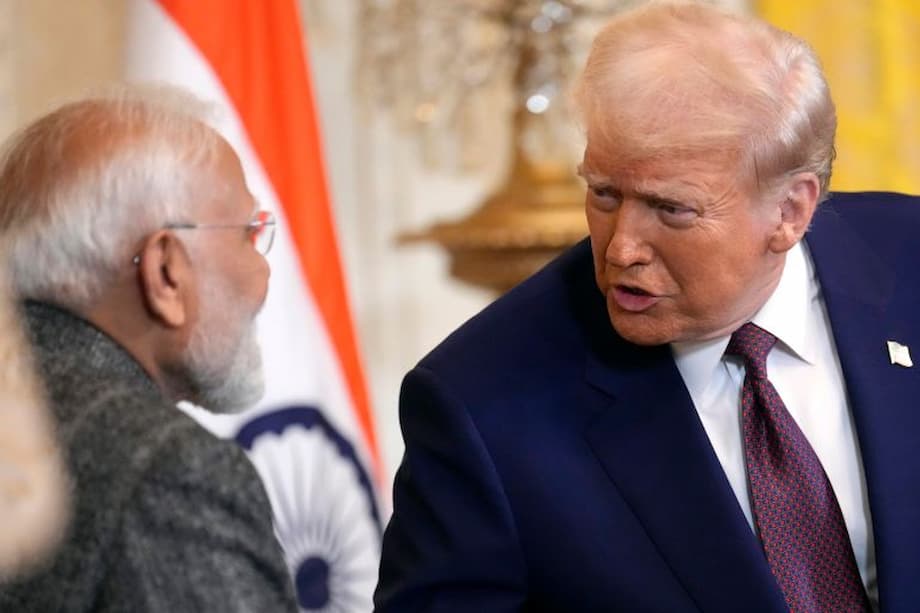US-India Ties at a Crossroads: The Shock of 50% Tariffs
The relationship between the United States and India—once hailed as a cornerstone of 21st-century geopolitics—has entered its most turbulent phase in decades. On Wednesday, President Donald Trump announced a sweeping new set of tariffs, raising duties on Indian imports to a staggering 50 percent. This move, intended as punishment for India’s continued purchase of Russian oil, has sent shockwaves through diplomatic, economic, and business circles in both countries and beyond.
- US-India Ties at a Crossroads: The Shock of 50% Tariffs
- Why Did Trump Impose Such High Tariffs on India?
- The Breakdown of Trade Negotiations: What Went Wrong?
- Economic Fallout: Who Gets Hurt?
- Geopolitical Ripples: China, Pakistan, and the Global Order
- Paths Forward: Can US-India Relations Recover?
- In Summary
For years, Washington and New Delhi have worked to deepen their partnership, driven by shared interests in trade, technology, and balancing China’s growing influence. But the sudden escalation in tariffs, combined with public barbs and failed negotiations, now threatens to unravel much of that progress. The implications stretch far beyond the two capitals, touching global supply chains, energy markets, and the delicate balance of power in Asia.
Why Did Trump Impose Such High Tariffs on India?
The immediate trigger for the tariff hike is India’s robust trade relationship with Russia, particularly its imports of discounted Russian oil. Since the start of the Ukraine war in 2022, India has dramatically increased its purchases of Russian crude, rising from under 100,000 barrels per day to over 1.8 million barrels per day by 2023. This now accounts for nearly 40 percent of India’s total oil imports, a shift that has saved billions for the Indian economy but drawn ire from Washington.
President Trump has accused India of helping finance Russia’s war in Ukraine, arguing that such purchases undermine Western efforts to pressure Moscow. In a statement accompanying the tariffs, Trump said, “India is fueling the war machine against Ukraine.” He also threatened further penalties if India does not curtail its Russian oil imports, and has publicly criticized India’s economy, calling it a “dead economy” alongside Pakistan’s.
However, Indian officials have pushed back strongly. India’s Ministry of External Affairs called the tariffs “unfair, unjustified and unreasonable,” emphasizing that energy security for its 1.4 billion citizens is a sovereign priority. They also pointed out that the European Union and the US themselves continue to trade with Russia in various sectors, and that India only turned to Russian oil after traditional suppliers redirected their exports to Europe.
Geopolitical Motives and the Russia Factor
While the tariffs are officially about trade, the underlying motives are deeply geopolitical. Trump’s administration has made ending the war in Ukraine a signature goal, and sees economic pressure on Russia’s partners as a key lever. India’s refusal to join Western sanctions against Russia, and its growing role as a major buyer of Russian energy, have made it a target for US pressure.
Yet, India’s relationship with Russia is not new. For decades, Russia has been India’s top supplier of arms and a reliable partner in energy and technology. While India has diversified its defense imports in recent years—buying more from the US, France, and Israel—its military still relies heavily on Russian equipment and support.
Trump’s move is also seen as part of a broader push for “onshoring” US manufacturing and reducing reliance on foreign partners, even those considered friendly. This marks a shift from the earlier strategy of “friend-shoring,” where the US encouraged supply chains to move to allied countries like India as an alternative to China.
The Breakdown of Trade Negotiations: What Went Wrong?
The tariff escalation comes after months of failed trade talks between Washington and New Delhi. Both sides had expressed optimism about doubling bilateral trade to $500 billion by 2030, up from $212 billion last year. India had offered concessions, including removing levies on US industrial goods, increasing defense and energy purchases, and scaling back taxes on cars. However, it refused to open its sensitive agriculture and dairy sectors—industries that employ hundreds of millions of Indians and are politically untouchable.
According to Vina Nadjibulla, vice president of strategy and research at the Asia Pacific Foundation of Canada, “This is a very difficult moment, arguably the worst in many, many years in their relationship and puts India in a very small group of countries that find themselves without a deal and with the highest tariff rates.”
The US, meanwhile, has struck deals with other major trading partners—including the European Union, Japan, South Korea, and Vietnam—setting tariffs at 15 to 20 percent in exchange for market access and investment commitments. India, along with Brazil, now faces the highest tariff rate globally at 50 percent, a status that is both economically damaging and diplomatically isolating.
Domestic Pressures and Political Calculations
Domestic politics have played a significant role on both sides. In the US, issues like immigration, offshoring, and technology sharing with India have become highly partisan. Trump’s administration has also courted Pakistan, hosting its army chief and offering lower tariffs in exchange for cooperation on energy and minerals—moves that have further strained ties with India.
In India, Prime Minister Narendra Modi faces pressure not to appear weak in the face of US demands. Modi has repeatedly emphasized that national security and economic sovereignty will guide India’s foreign policy decisions. Opening up the agriculture and dairy sectors is seen as politically impossible, especially with national elections on the horizon.
Economic Fallout: Who Gets Hurt?
The economic impact of the tariffs is already being felt. The new duties are expected to affect about 4.8 percent of India’s total exports, with sectors like textiles, chemicals, footwear, and jewelry most at risk. Major US retailers have paused orders from India, and Indian exporters are bracing for a sharp decline in sales to their largest market. According to Moody’s Ratings, the tariffs could shave 0.3 percent off India’s GDP growth.
For American consumers, the tariffs are likely to mean higher prices on everyday goods, from clothing to food and cars. US businesses that rely on Indian suppliers are scrambling to adjust supply chains, raise prices, or cut staff. The tariffs also add to the uncertainty already created by Trump’s broader trade war, which now affects more than 90 countries.
Ajay Srivastava, a former Indian trade official, warned that the US action “will push India to reconsider its strategic alignment, deepening ties with Russia, China and many other countries.” India has already begun pivoting to alternative markets, strengthening trade ties with Brazil, the UK, and the European Union.
Impact on Defense and Technology Cooperation
One of the most immediate casualties of the tariff dispute is defense cooperation. India has reportedly paused plans to buy US weapons and aircraft, including Stryker combat vehicles, Javelin antitank missiles, and Boeing P8I reconnaissance planes. While the Indian government has denied that talks are officially suspended, officials say no forward movement is expected until the tariff issue is resolved.
This is a significant setback for both countries. India is the world’s second-largest arms importer, and the US has been eager to expand its share of the Indian defense market, both for economic and strategic reasons. The broader defense partnership—including intelligence sharing and joint military exercises—remains intact, but the chill in relations could slow future cooperation.
Geopolitical Ripples: China, Pakistan, and the Global Order
The US-India split comes at a time of heightened global uncertainty. Both countries have worked together as part of the Quad (with Japan and Australia) to counter China’s influence in the Indo-Pacific. The US has traditionally seen India as a key partner in balancing China, and vice versa. The current rift could weaken that alignment, especially as India explores closer ties with other powers.
Trump’s administration has also engaged more closely with Pakistan, signing deals to develop its oil reserves and offering lower tariffs. This has not gone unnoticed in New Delhi, where memories of past US-Pakistan alliances run deep. The recent conflict between India and Pakistan in May, and Trump’s claims of brokering a ceasefire (which India denies), have added to the mistrust.
Meanwhile, China remains the largest buyer of Russian oil, but has so far avoided similar US penalties. This has fueled perceptions in India that it is being unfairly singled out, and could push New Delhi to hedge its bets by deepening engagement with Beijing and Moscow.
Global Trade Disruption and Supply Chain Shifts
The new tariffs are part of a broader global trend toward protectionism and economic nationalism. Trump’s executive orders have upended supply chains, driven up prices, and forced countries to rethink their trade strategies. Some, like Switzerland, are even considering closer integration with the European Union to mitigate the impact.
For India, the timing is especially challenging. The country has been trying to position itself as a manufacturing hub and an alternative to China for global businesses. Apple, for example, announced plans to assemble all iPhones for the US market in India by next year. But with a 50 percent tariff tag, India’s attractiveness as a destination for foreign investment is now in question.
Paths Forward: Can US-India Relations Recover?
Despite the current acrimony, many analysts believe that the US-India relationship is too important to be derailed permanently. The two countries share deep economic, technological, and strategic ties, and have weathered past crises. However, the foundation of bipartisan support that has underpinned the partnership for over two decades is now showing cracks.
Robert Rogowsky, a professor of international trade, expects “very creative diplomacy in the near term as India and the US try to reset ties despite tensions.” Former diplomats and experts advise India to negotiate calmly, prioritize its national interests, and signal to Washington the value of the partnership—if the US respects India’s boundaries.
There are signs that both sides are leaving the door open for a deal. The tariffs are set to take effect in stages, with a window for negotiations before the full 50 percent rate is implemented. India has indicated it is willing to scale back Russian oil imports if prices are comparable elsewhere, and the US has a history of reversing course on tariffs when it suits broader strategic goals.
For now, India is focusing on strengthening trade ties with other partners, including the UK and the EU, and stabilizing relations with China. Modi is expected to attend the Shanghai Cooperation Organisation summit in China, his first visit since the 2020 border clash. The outcome of these diplomatic maneuvers will shape not only the future of US-India relations but also the broader architecture of global trade and security.
In Summary
- The US has imposed a 50 percent tariff on Indian imports, the highest rate for any major trading partner, in response to India’s continued purchase of Russian oil.
- The move has plunged US-India relations to their lowest point in decades, ending a period of growing partnership and cooperation.
- India has called the tariffs unfair and vowed to protect its national interests, citing energy security for its 1.4 billion people.
- The tariffs are expected to hurt key Indian export sectors and raise prices for American consumers, while disrupting global supply chains.
- Defense cooperation and technology partnerships have been affected, with India pausing some planned US arms purchases.
- The rift has geopolitical implications, potentially weakening efforts to counter China and reshaping alliances in Asia.
- Both sides face domestic political pressures, making compromise difficult but not impossible.
- Analysts believe the relationship can recover, but only with creative diplomacy and mutual respect for each country’s core interests.












